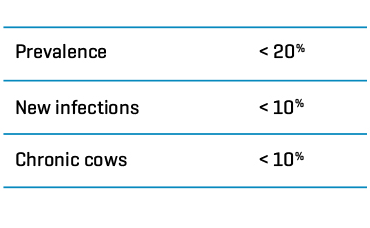Detection method depending on the pathogen we are dealing with:
DETECTION METHODS
A | Clinical mastitis
Remember that we defined what a clinical mastitis is previous post.
The best approach is to have a mastitis register sheet to keep a record of the number of cases, treatments, duration, severity, etc, on the farm (the form referred to in sanitary index).
Detection of clinical mastitis is based on 3 parameters. Depending on how many are affected, we will have a different grade of mastitis. The classification is as follows:
To collect the data from clinical mastitis, we recommend using a form to record all of the information:
- Total cases: percentage of mastitis cases in one year. The goal is to be under 40%.
- Repeated cases: percentage of the total cases which are not first cases <20%.
- Clinical mastitis in the first 30 days of lactation: percentage of animals showing clinical mastitis in the first 30 days of lactation (should be under 9%).
- Severity: proportion of severe cases (udder or cow affected) out of all the cases. The goal is to be below 20%.
B | Subclinical mastitis
We refer to a subclinical mastitis when the signs are not easily appreciated. To detect the inflammatory process, it’s needed some milk tests.
California Mastitis Test (CMT)
This is a subjective test which allows us to estimate the quantity of somatic cells in a cow in each quarter. It should be done every two weeks if there is no monthly individual control on the farm, and in every animal at the beginning or end of lactation. Sometimes is also called Rapid Mastitis Test (RMT).
The person who does the CMT must consider the following standards:
• Stripping before sampling is very important because the first jets can give false positives.
• CMT has to be done at the beginning of the milking because it is easier to identify due to the
quantity of pathogens.
The table below shows the relationship between the CMT result and its equivalence according to the SCC.
Electrical conductivity
We can find this system integrated in the majority of the automatic milking systems, the lecture is based on the measurement of ions. This method works with the difference in conductivity (due to salt concentration) concentration between infected and non-infected quarters. The problem is that it frequently fails when SCC is between 100,000 and 400,000 cells/ml and other factors (stress, heat, etc.) may interfere and cause changes in conductivity.
SCC
It’s based on the measurement of cells in milk, most of the somatic cells we can find in the milk are leukocytes (97%) and epithelial cells, among others. If the udder is under and infectious process, the amount of somatic cells increase due to the increase of the leukocytes.
• Bulk-tank somatic cell count (BTSCC)
This is like an X-ray of the herd and it advises us about the problem but does not define it either at herd or at individual level.
It is an economic parameter and is used as one of the criteria to pay for the milk according to quality. A bulk tank with a SCC over 400,000 cells/ml (geometrical average from 3 months) will not be collected by the industry in most countries.
• Individual Somatic cell count (ISCC)
I’ts recommended to measure it at least every month. The scientific community considers as healthy, a cows with a SCC below 200,000 cells/ml. If a cow is above this threshold and there’s no clinical symptoms, it’s considered that the cow is subclinically infected. The threshold can vary, per example, when talking about heifers, it’s recommended to use a limit of 100,000 cells/ml instead of 200,000 cells/ml. The variation is due to the fact that the SCC is mostly altered by intrammamary infections (IMI), however there is a variation because of other factors like for example age, season, other diseases…
Monthly ISCC helps us to work with the sanitary index and make decisions based on changes detected and comparison of results from different testing points.
First infections:
Percentage of cows which have more than 200,000 cells/ml first control after calving (correct is under 15%).
New infections risk:
Percentage of cows >200,000 cells/ml in the present control which were <200,000 cells/ml in the previous (Goal<10%).
Chronic cows:
Percentage of cows with more than 200,000 cells/ml in 2 consecutive months (goal <10%).
Healthy cows:
Percentage of animals below 200,000 cells/ml. Normally it should be more than 80% of the cows.
C | Diagnosis methods
Sampling for microbiological analysis and PCR are the most accurate diagnostic tools, that will guide us to target the main pathogen causing mastitis. There are other methods detect mastitis, but we cannot consider it as “real” diagnosis.
Having the bacterial culture/count of each type of germ can help in diagnosis, allowing us to identify where the problem is and what type of measures we need to apply. The classification of the infection is shown in the above table. However it must be remembered that potential faecal origin bacteria such as coliforms and some Streptococci not agalactiae might not originate from an intramammary source and merely be bulk tank contaminants.
Individual culture
As the samples are taking by identified cows, it’s useful to identify the main pathogen and be able to establish the adequate action plan, it can be just a treatment or depending on the pathogen can be useful to vaccinate the hole herd, if the pathogen is complicated maybe we should consider culling the cow, and/or segregation. The individual culture is useful in cases of cows that presents clinical cases and/or elevated SCC.
Bulk tank culture
With the culture of the milk tank, we should be careful with the interpretation of the results and keep in mind that are sampling the whole herd.
PCR
PCR-based methods have good reliability and it can be used as a complement to bacterial culture (Individually or Bulk tank). Bacterial screen is limited, but the sensitivity is very high as it will detect live and dead bacteria (as long as there’s DNA material). The results can be ready in 4 hours.
ADDITIONAL READING
- A Practical Look at Contagious Mastitis. NMC www.nmconline.org
- A Practical Look at Environmental Mastitis. NMC www.nmconline.org
- Prototheca, Yeast, and Bacillus as a Cause of Mastitis. Ruben
- N. Gonzalez 1996 National Mastitis Council Annual Meeting Proceedings page 82.
- Udder Health. Large Herd edition . J. Hulsen, T. Lam, Y. Schukken (2013)
- Environmental mastitis: know your opponent. K. Larry Smith and J.S. Hogan NMC Regional Meeting Proceedings (2008).



